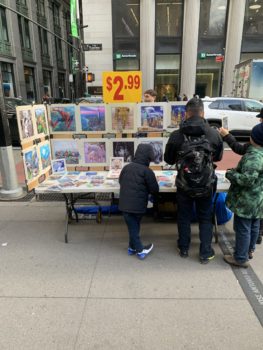Parks’ rules limited where vendors of expressive material could sell their wares in City parks. The Parks Department adopted “Expressive Matter Vending Rules” which restricted the sale of “materials or objects with expressive content, such as newspapers, books, or writings, or visual art such as paintings, prints, photography, or sculpture.” The new rules limited the sale of expressive materials to 100 specifically designated spots in Union Square Park, Battery Park, High Line Park, and Central … <Read More>
Search Results for: Vending
Artist vending restrictions clear judicial hurdle
Artists asked federal court to prevent Parks’ expressive-matter vending rules from taking effect. The Department of Parks and Recreation promulgated rules restricting where art and book vendors could sell their wares, also known as “expressive matter.” Among other things, the rules limited the locations where expressive matter display stands could be placed in Battery Park, Union Square, the High Line, and parts of Central Park. Shortly after the rules were published, two groups of artists … <Read More>
Charter Revision Commission Approves Ballot Proposals for November, Leaves Out Council Bill
On July 29, 2024, the 2024 New York City Charter Revision Commission (CRC) approved five ballot proposals following their final public meeting. The proposals include: clean streets, fiscal responsibility, capital planning, public safety, Minority and Women-Owned Business Enterprises, and modernization of City operations.
Clean Streets
This proposal aims to strengthen New York City Department of Sanitation’s ability to keep New York City healthy, safe, and clean by enhancing and clarifying its authority.
The amendment provides … <Read More>
City Announces New Rule Prohibiting Vendors on City Bridges
On January 3, 2023, the Department of Transportation announced new rules that restrict vending on city-owned bridges. Under the new rules, vendors will not be allowed to sell on pedestrian walkways, bike lanes on bridges and bridge approaches. The rule was made in part to address the excessive crowding on the Brooklyn Bridge.
City Council Approves Changes to Street Vendor System
The new bill releases 4,000 new street vendor permits over the course of ten years. On January 28, 2021, the City Council voted to approve Int 1116-B, which provides significant changes to the street vendor system. Prior to the legislation, the number of street vendor permits had been capped at 3,000 since 1983. Given the high demand for permits, limiting the number of permits opened an illegal market for renting out permits. Int 1116-B, sponsored … <Read More>





